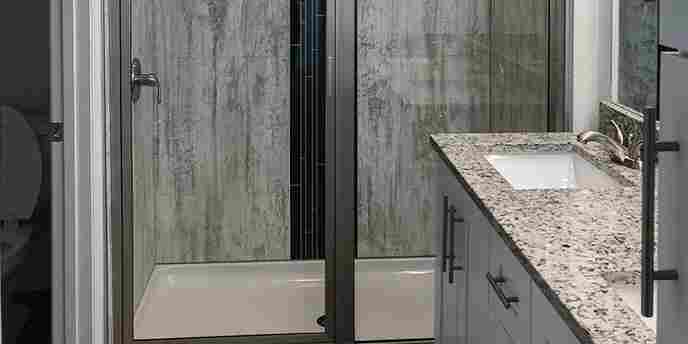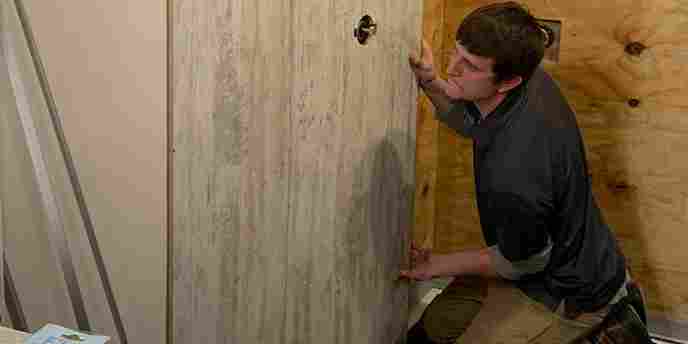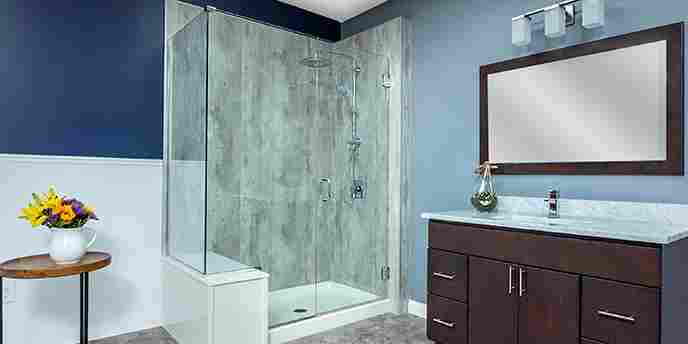Converting a dated, unused bathtub to a shower is a stylish and practical update for any home. A walk-in shower can make your bathroom feel larger and more modern, while also making it more accessible for those with mobility issues.
If you’re dreaming of a luxurious shower, but aren’t sure how to begin a DIY bathtub conversion, we’re here to help. Learn how to replace your old tub with a shower in this simple five-step guide.
Considerations Before Replacing Your Tub With a Shower
Before you get started, there are a few important considerations to keep in mind. First, make sure the new shower design you choose is practical for your family’s lifestyle needs. If you have young kids (or are planning to), a bathtub may be more functional than a walk-in shower.
Second, you should take into account the layout of any other bathrooms in your home. According to the National Association of Home Builders, having at least one bathtub in the house is important to the majority of homebuyers, which should be noted if you ever plan to sell your home.
Finally, you should plan ahead for every aspect of the bathtub-to-shower conversion. The shower style and fixtures you choose should not only match your taste, but should also fit your budget.
Budget for all associated costs before starting the project, including the shower kit itself and the materials and tools you’ll need for installation. In addition, plan for how you’re going to clean up and any professionals you may need to hire along the way.
Materials You’ll Need:
You should also consider renting a 10 yard dumpster to get rid of your old tub, drywall, tile and any other project debris, since most cities won’t accept these items for curbside pickup. Cities that do accept bathtubs and renovation waste still usually require you to wait for a monthly or yearly bulk collection day, leaving you with an eyesore on your lawn or driveway for longer than you (or your neighbors) would like.
“When deciding on a shower that fits your style and budget, first determine how much maintenance you want to deal with. Tile systems are more expensive and labor-consuming, but there are a lot of options that offer a fancier look. For a home-flipping project, you might use an acrylic or fiberglass shower surround kit, which is more generic in style but cheap. In the middle of the budget band is a shower wall panel (laminate or solid surface stone), which is stylish, durable and cost-effective.”
Mike Foti | Innovate Building Solutions

Photo Courtesy of Innovate Building Solutions
5-Step Guide to a DIY Bathtub-to-Shower Conversion
1. Determine Spacing and Placement
When converting a tub to a walk-in shower, it’s best to install your new shower in the space left behind by your bathtub, since the drain lines and water supply will already be in place. Moving plumbing will add significant costs to the project, and you’ll need to hire a plumber to do the work properly.
Spacing Required for a Walk-In Shower:
2. Decide on Walk-In Shower Design
When you’re going the DIY route for replacing your tub with a shower, using a shower stall kit is a very appealing option.
Kits are relatively simple for a DIYer to install on their own, and they come in a range of styles, including square corner, round corner and alcove showers. Some options even allow you to tile them to match the rest of your bathroom.
You’ll also need to decide whether to go curbed or curbless.
Comparing Shower Stall Kits
| Description | Pros | Cons | Average Cost | |
| Curbed Showers | Shower pan forms a complete enclosure using low curbs you must step over to enter the shower. | Most common type of walk-in shower and the easiest to install. | Could pose the same problems as your old bathtub for those with mobility issues. | $600 – $1,000 |
| Curbless Showers | Shower pan sits flush with the floor, with no enclosures. | Easily accessible for anyone with mobility issues. Increasingly popular due to their visual appeal. | Pricier and requires more work to install than curbed options. | $1,800 – $4,000 |
“You should think about how you’ll prevent water from getting out of your new shower, and what that’s going to look like. For example, are you going to have room for a pivoting door opening out into the space, or does it need to be a sliding door? Will the person using this shower be able to step over a 4-inch curbed pan long-term?
When looking at a shower or tub, think not just about today, but about how your living arrangement might change, and be thoughtful of that in your design.”
Mike Foti | Innovate Building Solutions
3. Remove Tiles and Wall Sections
Before you replace your tub with a walk-in shower, you’ll need to remove some of the tile and drywall around the bathtub in order to tear it free.
To prepare the area for your bathtub removal, you’ll need to:

Photo Courtesy of Innovate Building Solutions
Pro Tip: “If you’re tiling your shower, make sure you’re using the right grout. You can’t use unsanded grout in the shower – if the grout joint breaks down, water will move through it. The backer system should also be water resistant. Paying a little extra to make sure you’re properly waterproofed during the remodeling process can save you a ton of time and money in the long run.”
Mike Foti | Innovate Building Solutions
4. Remove the Bathtub
Now, for the moment you’ve been waiting for – getting rid of that old tub.
Use these five easy steps to remove your bathtub and make room for your new shower.
Removing your tub will expose the concrete backing board and subfloor underneath, so now is a good time to assess and fix any damage it may have. Subfloor damage is usually caused by overexposure to moisture, and if your subfloor needs to be replaced , you’ll save yourself a lot of time and stress down the road by taking care of the issue now.
“Plumbing work should always be done by a professional. A lot of homeowners can handle the removal of a tub after shutting the water off, but if you’re replacing the tub with a shower, it may impact your plumbing system and require a change in pipe size. The worst-case scenario in this process is if you get a leak and destroy the floor below.”
Mike Foti | Innovate Building Solutions
5. Install Your Walk-In Shower
Once you’ve removed your old tub, you’re ready to replace it with the new shower.
Follow the specific instructions for your shower stall kit, and you’ll be in the home stretch. If you’re converting to a curbless walk-in shower, keep in mind that you’ll first need to lower the floor of the shower area so that the shower pan will sit flush with the rest of the bathroom floor.
If your bathroom has a slab subfloor, you’ll need to hire a concrete contractor for this step. Fortunately, this is typically a quick job that shouldn’t break your budget.
If your subfloor isn’t slab, you can get a permit from your city’s building department to cut down the tops of the floor joists beneath the shower pan until it sits level.
Pro Tip: “To ensure everything fits together and is properly waterproofed, always put your tub/shower base in first before you install any tile or wall panels.”
Mike Foti | Innovate Building Solutions

Photo Courtesy of Simple Bath
Cleaning Up After Converting Your Tub Into a Walk-In Shower
Completing a DIY bathtub to shower conversion is a huge accomplishment for any homeowner, and when you’re finished, you should feel excited about your bathroom’s new look – not stressed about the cleanup.
The easiest way to keep your home in good shape while replacing your tub with a shower is to rent a home renovation dumpster and toss debris as you work. There are a variety of sizes for various projects and materials, so you can choose which one works best for your specific needs.
Feeling motivated to continue updating your home? Learn how to remodel the rest of your bathroom , and check out our DIY home improvement guide for even more renovation tips.
